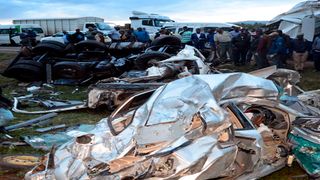
Onlookers view the wreckage of vehicles involved in a multiple crash involving six vehicles in Sachangwan in 2017.
| Sila Kiplagat | Nation Media GroupNews
Premium
Speeding, human error and bad road design blamed for accidents, deaths
Kenya’s roads are proving to be deadly, mercilessly taking lives at will every week, its users alive one moment and gone the next, while some are left with injuries that will scar them for life.
On July 1, the headlines on every media platform in the country were disheartening—a lorry speeding on the Londiani junction lost control (preliminary investigations indicate that there may have been a brake failure) and ploughed through everything on its way. In the aftermath, more than 50 people were dead while scores were injured.
The heavy truck swept trough the makeshift roadside kiosks and traders selling their wares at the junction.
Three days later, a bus bound for Siaya County, carrying dozens of students from on their way back to school after the half-term break, overturned in Mau Summit along the Nakuru-Kericho road. Fortunately, no one died, but one passenger was seriously injured and rushed to hospital.
These are just two high-profile accidents that occurred in the space of four days and on the same stretch early this month.
Pedestrians
But the sheer number of road deaths in Kenya tells a horrific story. From January to July 5, at least 2,318 people have died on the roads, according to data from the National Transport and Safety Authority. The majority of those who have died on the roads are pedestrians at 824, followed by motorcyclists at 605, drivers (425), pillion riders (213), car passengers (205) and cyclists at 48.
So far, the government, through the Ministry of Transport, has expressed its concern and announced a series of measures to curb such incidents in the future.
Since his appointment as Cabinet Secretary for Transport, Mr Kipchumba Murkomen has issued a record eleven directives to enforce safety standards on the roads. Key among them are the banning of school transport between 10pm and 5am, the requirement for all schoolchildren to be seated with functional seatbelts at all times, and the removal of all unroadworthy school vans and buses from the roads.
There has also been the introduction of the Intelligent Road Safety Management System, which, among other things, requires all vehicles weighing more than 3,049 kilogrammes to be fitted with speed limiters, and the most recent directive for the installation of cameras on the dashboards of commercial vehicles.
However, an analysis of accidents on busy roads by both the NTSA and the Kenya National Highways Authority shows that over 80 per cent of incidents are due to human error. This means that the actions of drivers and pedestrians are largely to blame for accidents and the resulting deaths and life-changing injuries suffered by survivors.
In a bid to streamline the sector and improve driver professionalism, the Department of Transport has called for the retesting and re-training of all passenger service vehicle and commercial drivers.
“From June 1, all drivers of passenger service vehicles and commercial vehicles whose licences expire will be required to undergo a mandatory medical fitness test before renewing their licences. From July 1, all PSV drivers will be subjected to a mandatory medical fitness test by a qualified medical practitioner before renewing their licences,” Mr Murkomen ordered.
Although these measures are concise and clear, the harrowing stories coming from various routes across the country are chilling.
Black spots
The Northern Corridor, according to KeNHA, accounts for the majority of the country’s black spots. The Kinungi-Naivasha-Gilgil route remains deadly. Not a month goes by without an accident on this stretch, which covers a good part of the Nairobi-Nakuru highway.
On April 18, six students died instantly when the matatu they were travelling in collided with a truck near Delamere Farm. Almost two weeks later, several passengers were injured in an accident involving a matatu and a private car in Nyakairo area near Kinungi. It was also in Kinungi that one person was killed when eight vehicles collided at the black spot in May. In November 2021, at least two people were killed after the driver of the ill-fated vehicle reportedly overtook recklessly.
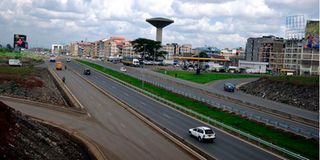
A section of Outer Ring Road in Nairobi.
Further down the same road, but now on the Nakuru-Eldoret stretch, there are several dangerous spots. Barely half an hour’s drive from Nakuru town is the dreaded Salgaa town.
On June 24, three people died there, including two students and a driver who were travelling in a matatu from Nakuru to Eldoret when it collided head-on with a lorry.
‘Nissan’ matatus have a capacity of 14 passengers, but this one had fifteen, most of them students returning home for the half-term break.
Road reserves
However, since the rehabilitation of the Salgaa-Sachangwan stretch, which was one of the most feared stretches in Kenya, the accident rate has dropped significantly. This is after KeNHA built a central barrier to separate the two lanes of traffic and improved road markings and signs.
Some 130 kilometres away is the other dreaded Kaburenge black spot, where six people died in a road accident on June 24 on the busy Eldoret-Webuye road. Five of the victims were students of Ebenezer Academy. They died on the spot after a truck lost control and rammed into their school bus.
Of concern to KeNHA, particularly for Londiani and Kaburenge, is the proliferation of traders on the road reserves who are at high risk of being killed in accidents that often occur when heavy trucks plying these routes lose control due to the steep nature of the roads.
However, Mr Murkomen said that all roads in the country will be assessed to identify and map all dangerous spots and sections so that appropriate action can be take.
This is already underway, NTSA deputy director Duncan Kibongong says, adding that several agencies have been involved to ensure that road safety is addressed through a multi-sectoral approach.
“One of the strategies we have adopted to ensure that the roads are safe is to relocate these people who have encroached on the road environment. We will work with them to ensure that they have a safe place to work,” he said.
Aside from the Northern Corridor, the Nairobi-Meru highway remains another deadly route, especially at the Nithi Bridge, which hit the headlines last year after a bus veered off the road and rolled off the bridge, killing at least 33 people on the spot. Witnesses said the bus driver was speeding before the vehicle lost control and plunged 40 metres into the Nithi River.
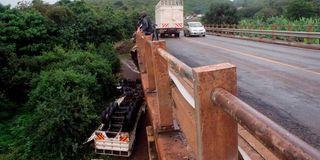
Scene of an accident involving a trailer along the Nyeri-Nairobi highway at Sagana Bridge on December 19, 2017.
The spot’s reputation is so well known that almost all presidential candidates have to make its safety a top priority during election campaigns to persuade locals to vote for them.
Last year, before the August General Election, both President William Ruto, then Deputy President and flagbearer of the Kenya Kwanza alliance, and Raila Odinga, flagbearer of the Azimio la Umoja One Kenya coalition, promised to fix the Nithi Bridge “problem” and ensure the safety of its users. To date, despite President Ruto’s election victory, the problem is yet to be fixed, awaiting the next accident and loss of lives.
Experts agree that the road needs to be redesigned to reduce the steep inclines and sharp bends. The governor of Tharaka Nithi, Muthomi Njuki, is also on record as having repeatedly called on the national government to repair what he called “the most dangerous bridge in North and Central Africa”, and has consistently called for the construction of pillars to support the road and avoid the steep drop that has long made it difficult for drivers to negotiate the sharp turn and descent at the same time.
KeNHA has confirmed to the Nation that the road design at Nithi Bridge is indeed to blame and is in the process of finalising the redesign plan for the stretch.
On the way to Mombasa City is the other danger spot of Kibarani, for long a death zone until the narrow road, often used by heavy trucks and large PSV buses, was upgraded.
The Makupa Causeway in the coastal city is another danger zone for motorists and commuters. In April 2021, three people died instantly after the matatu they were travelling in veered off the road and rammed into a speeding truck. Residents complained that this was the fourth accident on the same stretch in four months and called on the government to install safety pillars and a median barrier.
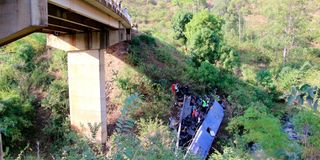
The wreckage of a bus that plunged into the Nithi River bridge along the Meru-Nairobi highway, killing 34 people in 2022.
The government agreed and dualled the road. It was a long time before another accident occurred there.
In Nairobi, the Outer Ring road from Thika Road in the Allsops area to Mombasa Road is the deadliest 13-kilometre stretch for its users, according to the NTSA. In 2021, the road claimed at least 32 lives. It is followed by Mombasa Road, Northern Bypass, Waiyaki Way, Southern Bypass, Eastern Bypass, Kangundo Road, Ngong Road, Juja Road and Jogoo Road.
On these roads in the capital, pedestrians account for at least 90 per cent of all fatalities.
To address the black spots that continue to claim lives, Mr Murkomen last month directed KeNHA, NTSA and Kenya Urban Roads Authority (Kura) to complete road safety audits of all black spots and ensure safety interventions, including installation of signage, reflectors and street lighting, within the next month.
Speeding by drivers remains a major road safety concern, with an estimated 30 to 40 per cent of fatal road accidents involving speeding.
For this reason, speed limiters have been installed on PSVs. The speed limiter limits the speed of the vehicles, then transmits the speed data at set intervals to the data centre and NTSA servers, which data should be retained for a set period of time.
“Since being deployed on the NTSA platform, the speed limiter has so far shown a very positive response in the PSV drivers’ speed management behaviour. Our data and evidence clearly shows that the speed of the onboarded PSVs has been reduced, resulting in fewer road accidents,” says Mr Murkomen.
There are plans to expand this strategy to ensure that all PSVs and HCVs have speed limiters integrated into the NTSA platform.
Also Read: NTSA reveals Nairobi’s most dangerous roads
Curriculum support material for teaching road safety in schools are also being procured by the government, which aims to integrate road safety education into the school system.
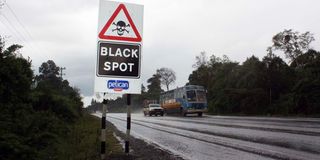
A road sign at Sachangwan area on Nakuru-Eldoret highway.
These materials will be used by teachers and students to train them on all aspects of road safety and this will be done through the involvement of the Kenya Institute of Curriculum Development.
The Ministry has also developed the National Road Safety Action Plan 2023-2027, which will guide all road safety interventions in the country over the next five years, with clear targets and implementers for each target.
Among the strategies to be implemented in the action plan is the conduct of comprehensive road safety audits, which will be integrated into the design stages of roads to ensure that the road system incorporates all road safety infrastructure features.
Shared responsibility
“The national plan has a target of reducing fatalities by 50 percent by 2030 and we intend to launch this multi-sectoral plan in August 2023,” said Mr Murkomen.
Although these measures are being implemented, the buck stops with road users, including motorists, cyclists and pedestrians, who must obey the traffic rules and obey the signs posted at various points on the country’s roads.
“Road safety is a shared responsibility. Everyone has to play their part. The government will play its part, as will everyone else,” the minister said.





